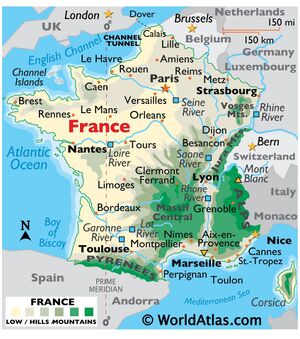Moselle
| Author:Laxman Burdak, IFS (R) |

Moselle (Hindi: मोसेल्ले नदी, /moʊˈzɛl/ moh-ZEL,[1] French: [mɔzɛl]; German: Mosel [ˈmoːzl̩]; Luxembourgish: Musel [ˈmuzəl]) is a river that rises in the Vosges mountains and flows through north-eastern France and Luxembourg to western Germany. It is a left bank tributary of the Rhine, which it joins at Koblenz. A small part of Belgium is in its basin as it includes the Sauer and the Our.
Variants
- Moselle Franks - tribe
- Mosellians - tribe
Jat clans
Moselle tribe
Moselle Franks or Mosellians were Germanic tribe who were Subset of the Franks, separated from the Ripuarian Franks in the 5th century. They lived near Upper Rhine and Moselle.
Course
Its lower course "twists and turns its way between Trier and Koblenz along one of Germany's most beautiful river valleys."[2] In this section the land to the north is the Eifel which stretches into Belgium; to the south lies the Hunsrück. The river flows through a region that was cultivated by the Romans. Today, its hillsides are covered by terraced vineyards where "some of the best Rieslings grow".[3] Many castle ruins sit on the hilltops above wine villages and towns along the slopes. Traben-Trarbach with its art nouveau architecture and Bernkastel-Kues with its traditional market square are two of the many tourist attractions on the Moselle river.
Name
The name Moselle is derived from the Celtic name form, Mosela, via the Latin Mosella, a diminutive form of Mosa, the Latin description of the Meuse, which used to flow parallel to the Moselle. So the Mosella was the "Little Meuse".
The Moselle is first recorded by Tacitus in Book 13 of his Annals[4] and in Book 4 of his Histories.[5]
The Roman poet Ausonius made it a literary theme as early as the 4th century. In his poem dated 371, called Mosella, which was published in 483 hexameters, this poet of the Late Antiquity and teacher at the Trier Imperial Court (Kaiserhof) described a journey from Bingen over the Hunsrück hills to the Moselle and then following its course to Trier on the road named after him, the Via Ausonius. Ausonius describes flourishing and rich landscapes along the river and in the valley of the Moselle, thanks to the policies of their Roman rulers.
The river subsequently gave its name to two French republican départements: Moselle and Meurthe-et-Moselle.
List of tributaries
- From the left
Madon, Terrouin, Esch, Rupt de Mad, Orne, Fensch, Gander, Syre, Sauer, Kyll, Salm, Lieser, Alf, Endert, Brohlbach, Elz.
- From the right
Moselotte, Vologne, Meurthe, Seille, Saar, Olewiger Bach, Avelsbach, Ruwer, Feller Bach, Dhron, Ahringsbach, Kautenbach, Lützbach, Flaumbach, Altlayer Bach, Baybach, Ehrbach.
Towns
Towns along the Moselle are:
- in France: Épinal, Toul, Pont-à-Mousson, Metz and Thionville
- in Luxembourg: Schengen, Remich, Grevenmacher and Wasserbillig
- in Germany: Konz, Trier, Schweich, Bernkastel-Kues, Traben-Trarbach, Zell, Cochem and Koblenz
Adjacent mountain ranges
From Trier downstream the Moselle separates the two Central Upland ranges of the Eifel (to the northwest) and the Hunsrück (to the southeast).
History
The Moselle was known to the Romans by the name of Flumen Musalla (in the Tabula Peutingeriana), and the river was romanticised by the poet Ausonius around 371. From 1815, the Moselle formed the border between the Grand Duchy of Luxembourg and Prussia (German Empire in 1871).
The River was canalised between Metz and Thionville, via a canal opened in 1964 by the Grand Duchess, Charlotte of Luxembourg, the Federal Chancellor of Germany, Konrad Adenauer and their host, Charles de Gaulle, President of France.[6]
It is on the Moselle, at the site of the France–Germany–Luxembourg tripoint, that the Schengen Agreement was signed in 1992, establishing the free movement of goods and people in the European Community.
External links
See also
References
- ↑ https://www.ahdictionary.com/word/search.html?q=Moselle
- ↑ Moselle: Holidays in one of Germany's most beautiful river valleys at www.romantic-germany.info.
- ↑ Moselle: Holidays in one of Germany's most beautiful river valleys at www.romantic-germany.info.
- ↑ Publius Cornelius Tacitus: Der Text ist verfügbar in der lateinischen Wikisource: Kapitel LIII, at la.wikisource.org
- ↑ Publius Cornelius Tacitus: Der Text ist verfügbar in der lateinischen Wikisource; erwähnt ist die Mosel in Kapitel 71 und Kapitel 77, at la.wikisource.org
- ↑ Institut National de l’Audiovisuel – Ina.fr. "La canalisation de la Moselle". Ina.fr.
Back to Rivers